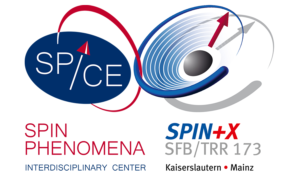On-line SPICE-SPIN+X Seminars
On-line Seminar: 8 July 2020 - 15:00 (CET)
Towards deep neural networks with nanoscale spintronic oscillators as neurons
Julie Grollier, CNRS-Thales

Spintronic oscillators are nanoscale devices realized with magnetic tunnel junctions which have the potential to be integrated by hundreds of millions in electronic chips. Their non-linear dynamical properties are rich and tunable, and can be leveraged to imitate different features of biological neurons. High performance pattern recognition was achieved through the coupled dynamics of the oscillators in small circuits. The transient dynamics of a single spintronic nano-oscillator has been used to implement reservoir computing, achieving state-of-the-art results on a simple spoken digit recognition task [1], [2]. Four spintronic nano-oscillators have been trained to classify spoken vowels by phase locking their oscillations to the strong input signals produced by external microwave sources [3]. Three spintronic nano-oscillators did bind temporal data through their mutual synchronization [4].
These demonstrations now need to be scaled to deep networks to establish their potential definitely. The neocortex, the seat of higher cognitive functions in the brain, has a hierarchical structure of six layers of neurons. Adopting such a layered structure in artificial neural networks was the key to their fantastic progress in the last ten years. Neuromorphic systems need to be scalable to deep networks to truly establish their promises.
PDF file of the talk available here
A key asset of spintronic nano-oscillators towards this goal is their ability to emit radio-frequency (RF) signals. These oscillators indeed produce microwave voltages with varying amplitude and frequency in response to direct current inputs. They could therefore potentially communicate through radio-frequencies signals, allowing fully parallel operation with minimized wiring, at a speed seven orders of magnitude faster than the brain. But for this, it is necessary to devise radio-frequency synapses that can interconnect the oscillators.
In this talk, I will rapidly review recent results on neuromorphic computing with spintronic nano-oscillators. I will then describe how they can be interconnected layer-wise through RF spintronic nano-synapses, and present our recent simulation results of classification with these novel RF synapses.
[1] J. Torrejon et al., « Neuromorphic computing with nanoscale spintronic oscillators », Nature, 547, 428‑431 (2017).[2] S. Tsunegi et al., « Physical reservoir computing based on spin torque oscillator with forced synchronization », Appl. Phys. Lett., 114, 164101 (2019).
[3] M. Romera et al., « Vowel recognition with four coupled spin-torque nano-oscillators », Nature, 563, 230,(2018).
[4] M. Romera et al., « Binding events through the mutual synchronization of spintronic nano-neurons », arXiv:2001.08044 (2020).



 Emerging phenomena, such as the spin-Hall effect (SHE), spin pumping, and spin-transfer torque (STT), allow for interconversion between charge and spin currents and the generation of magnetization dynamics that could potentially lead to faster, denser, and more energy efficient, non-volatile memory and logic devices. Present STT-based devices rely on ferromagnetic (FM) materials as their active constituents. However, the flexibility offered by the intrinsic net magnetization and anisotropy for detecting and manipulating the magnetic state of ferromagnets also translates into limitations in terms of density (neighboring elements can couple through stray fields), speed (frequencies are limited to the GHz range), and frequency tunability (external magnetic fields needed). A new direction in the field of spintronics is to employ antiferromagnetic (AF) materials. In contrast to ferromagnets, where magnetic anisotropy dominates spin dynamics, in antiferromagnets spin dynamics are governed by the interatomic exchange interaction energies, which are orders of magnitude larger than the magnetic anisotropy energy, leading to the potential for ultrafast information processing and communication in the THz frequency range, with broadband frequency tunability without the need of external magnetic fields.
Emerging phenomena, such as the spin-Hall effect (SHE), spin pumping, and spin-transfer torque (STT), allow for interconversion between charge and spin currents and the generation of magnetization dynamics that could potentially lead to faster, denser, and more energy efficient, non-volatile memory and logic devices. Present STT-based devices rely on ferromagnetic (FM) materials as their active constituents. However, the flexibility offered by the intrinsic net magnetization and anisotropy for detecting and manipulating the magnetic state of ferromagnets also translates into limitations in terms of density (neighboring elements can couple through stray fields), speed (frequencies are limited to the GHz range), and frequency tunability (external magnetic fields needed). A new direction in the field of spintronics is to employ antiferromagnetic (AF) materials. In contrast to ferromagnets, where magnetic anisotropy dominates spin dynamics, in antiferromagnets spin dynamics are governed by the interatomic exchange interaction energies, which are orders of magnitude larger than the magnetic anisotropy energy, leading to the potential for ultrafast information processing and communication in the THz frequency range, with broadband frequency tunability without the need of external magnetic fields. On-line Seminar: 10 June 2020 - 15:00 (CET)
On-line Seminar: 10 June 2020 - 15:00 (CET)



 In the time of physical distancing, it is more important than ever to remain close socially and scientifically. The Spin Phenomena Interdisciplinary Center SPICE and the Collaborative Research Center SPIN+X have joined forces to start a weekly condensed matter seminar series with an emphasis on spin and topological physics.
In the time of physical distancing, it is more important than ever to remain close socially and scientifically. The Spin Phenomena Interdisciplinary Center SPICE and the Collaborative Research Center SPIN+X have joined forces to start a weekly condensed matter seminar series with an emphasis on spin and topological physics.
